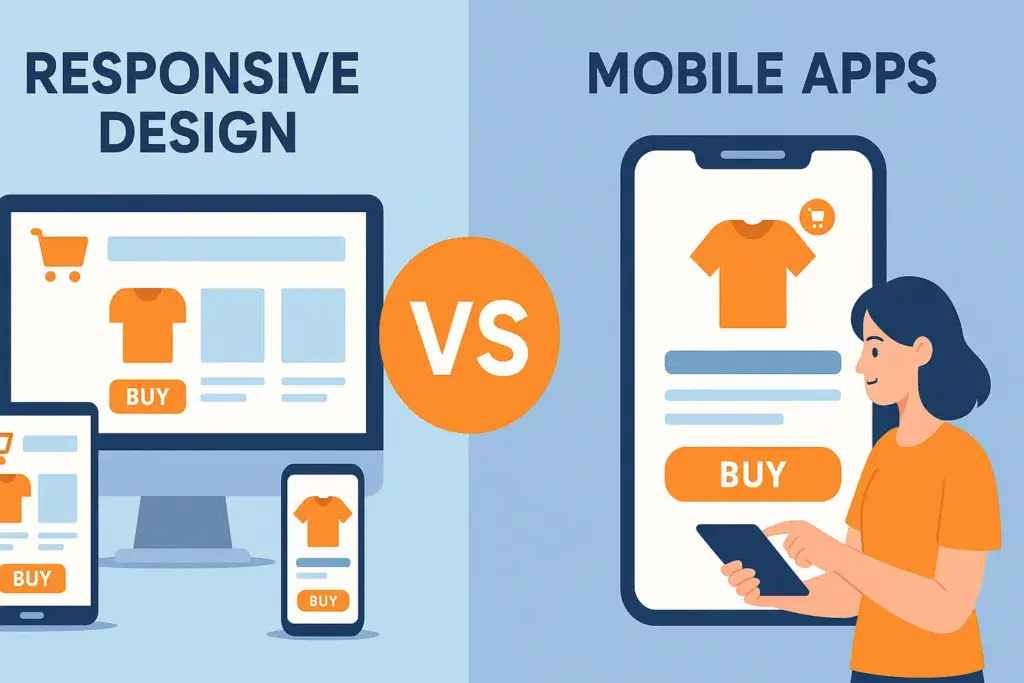
I. Introduction: Setting the Stage
In today’s mobile-driven digital economy, businesses cannot ignore the responsive design vs mobile apps question. Customers expect fast, smooth, and accessible online shopping experiences, whether they browse through a smartphone, tablet, or desktop. Over half of global web traffic comes from mobile devices, and that number is still rising. This makes the decision between responsive design vs mobile apps one of the most crucial choices for online stores.
A well-planned Responsive Design vs Mobile Apps strategy can significantly improve customer satisfaction, streamline purchases, and increase retention rates. Whether through a fast-loading responsive site or a feature-rich mobile app, the goal is to create a frictionless buying journey that meets modern consumer expectations.
For E-commerce businesses, understanding the importance of a mobile presence is paramount. A well-optimized mobile experience can enhance customer satisfaction, streamline the purchasing process, and ultimately drive higher conversion rates. As shoppers seek convenience and efficiency in their buying journeys, brands that prioritize their mobile interfaces can capture a larger share of the market.
When considering the best approach for mobile engagement, businesses often debate the merits of Responsive design vs mobile apps. Each option presents unique features and user experiences that can influence customer interaction and satisfaction.
Moreover, the shift towards mobile has brought about changes in consumer behavior. Today’s shoppers expect seamless interactions, personalized experiences, and fast-loading pages. They are more likely to abandon a cart if they encounter a cumbersome mobile site or app, highlighting the critical need for businesses to invest in their mobile strategies.
In this context, E-commerce companies must decide between developing a responsive design for their websites or creating dedicated mobile apps. Both options offer distinct advantages and challenges that can significantly impact user experience, engagement, and overall business performance. This article will explore these two approaches in detail, examining their features, benefits, and limitations, ultimately guiding businesses towards making informed decisions about their mobile presence, particularly focusing on Responsive design vs mobile apps, a critical consideration for today’s digital landscape. Additionally, understanding the nuances of both strategies is essential for achieving success in a mobile-driven market.
II. Understanding Responsive Design vs Mobile Apps
A. Definition and Principles of Responsive Design
Responsive design is an approach to web development that aims to create a seamless user experience across a variety of devices and screen sizes. By employing fluid grids, flexible images, and media queries, responsive design allows a website to adapt its layout and content dynamically, ensuring that users can easily navigate and interact with the site, regardless of whether they are using a desktop, tablet, or smartphone.
The core principles of responsive design include:
1. **Fluid Grids**: Instead of using fixed pixel widths, responsive design relies on relative units like percentages to define layout dimensions. This approach allows elements on the page to resize proportionally as the viewport changes.
2. **Flexible Images**: Images within a responsive design framework are set to scale with the grid. This ensures that visuals do not exceed their containing element, maintaining a consistent look across devices.
3. **Media Queries**: By utilizing CSS media queries, responsive design can apply different styles to a webpage based on the characteristics of the device being used, such as screen size, resolution, and orientation. This allows for tailored experiences that can enhance usability on smaller screens.
B. Benefits of Responsive Design for E-commerce Websites
The adoption of responsive design for e-commerce websites comes with a plethora of benefits:
1. **Improved User Experience**: By providing a consistent and optimized browsing experience across devices, responsive design helps users find products and complete transactions more easily. This can lead to higher satisfaction and a lower bounce rate.
2. **Cost Efficiency**: Maintaining a single responsive website is often more cost-effective than developing and managing separate sites or apps for different devices. This approach simplifies updates, maintenance, and overall management.
3. **SEO Advantages**: Search engines, particularly Google, prefer responsive design as it consolidates the website’s content under a single URL. This can positively impact search rankings and improve the website’s visibility in search results.
4. **Increased Reach**: As mobile browsing continues to grow, responsive design ensures that e-commerce businesses can reach a broader audience. Users are more likely to engage with websites that perform well on their devices, ultimately leading to increased traffic and sales.
C. Challenges of Implementing Responsive Design
Despite its numerous advantages, implementing responsive design is not without challenges:
1. **Complexity in Design**: Creating a responsive site requires careful planning and design considerations to ensure that all elements function and display correctly across different devices. This can increase the complexity of the development process.
2. **Performance Issues**: If not executed properly, responsive design can lead to larger file sizes and slower loading times, particularly on mobile devices. Developers must optimize images and scripts to maintain performance.
3. **Testing Across Devices**: Ensuring that a responsive site works flawlessly across a wide range of devices and screen sizes necessitates thorough testing. This can be time-consuming and may require specialized tools or services.
4. **Potential for Overwhelm**: The flexibility of responsive design can sometimes lead to overwhelming users with too much information or too many options on smaller screens. It’s crucial to prioritize content and streamline navigation for mobile users.
In summary, in the context of responsive design vs mobile apps, while responsive design offers significant benefits for e-commerce websites, it comes with its own set of challenges that need to be carefully managed.
Understanding these factors is essential for e-commerce businesses looking to enhance their mobile presence and provide an optimal shopping experience for their customers.
III. Exploring Mobile Apps for E-commerce
As the mobile landscape continues to evolve, many E-commerce businesses are gravitating towards mobile applications as a means to enhance user experience and drive sales. Mobile apps have emerged as powerful tools in the digital marketplace, providing unique features that can differentiate a brand and foster customer loyalty.
A. Features and Functionalities of Mobile Apps
Mobile apps for E-commerce offer a plethora of features designed to streamline the shopping experience. These apps can provide personalized content based on user behavior and preferences, allowing for a tailored shopping journey. Key functionalities often include:
1. **Push Notifications**: Apps can send real-time updates about new products, promotions, and personalized offers directly to users, enhancing engagement and encouraging repeat visits.
2. **Offline Access**: Many mobile apps allow users to browse products and access previously viewed items without an internet connection, which can be particularly beneficial for users in areas with limited connectivity.
3. **Seamless Checkout Process**: Mobile apps often feature simplified checkout processes that can include saved payment methods and address information, reducing cart abandonment rates and improving conversion.
4. **Integration with Device Features**: Apps can leverage device-specific features such as cameras for augmented reality experiences, GPS for location-based services, and biometric authentication for secure logins, creating a more interactive and convenient shopping experience.
B. Advantages of Using Mobile Apps for E-commerce
The benefits of adopting mobile apps for E-commerce are numerous and can significantly impact a business’s bottom line:
1. **Enhanced User Experience**: Mobile apps often provide a smoother, faster, and more intuitive user interface compared to mobile websites, leading to higher customer satisfaction.
2. **Higher Engagement Rates**: Due to features like push notifications and personalized content, apps typically see higher engagement and retention rates. Users are more likely to keep an app on their device than frequently visit a website.
3. **Customer Loyalty**: With integrated loyalty programs and rewards systems, mobile apps can foster a deeper connection with customers, encouraging them to return and make repeat purchases.
4. **Increased Sales**: Statistics indicate that mobile app users tend to spend more than mobile web users. The convenience and personalized experience offered by apps can lead to higher average order values and an increase in impulse purchases.
C. Drawbacks and Limitations of Mobile Apps
Despite their advantages, mobile apps also come with certain drawbacks and limitations that E-commerce businesses must consider:
1. **Development and Maintenance Costs**: Building and maintaining a mobile app requires a significant investment of time and resources, including ongoing updates and compatibility checks with various devices and operating systems.
2. **App Store Approval Process**: Launching an app involves navigating the app store approval process, which can be time-consuming and may require adherence to specific guidelines and standards.
3. **User Acquisition and Retention Challenges**: Attracting users to download and regularly use a mobile app can be challenging. Businesses need effective marketing strategies to promote their app and encourage downloads.
4. **Fragmentation Across Devices**: With a wide variety of devices and operating systems, ensuring a consistent experience for all users can be difficult. Developers must account for different screen sizes, resolutions, and performance capabilities.
In the ongoing debate of responsive design vs mobile apps, apps excel when businesses want to drive repeat sales, build long-term loyalty, and create immersive experiences.
They also require careful consideration of costs, development complexities, and user acquisition strategies. As the E-commerce landscape continues to shift towards mobile, businesses must weigh the pros and cons of mobile apps against their specific objectives and customer needs.
IV. Comparing Performance and User Experience
In the competitive landscape of E-commerce, understanding the performance and user experience of responsive design vs mobile apps is crucial for businesses aiming to optimize their digital presence. This section delves into three key areas: user engagement and retention rates, loading speeds and performance metrics, and the SEO implications for both responsive design and mobile applications.
A. User Engagement and Retention Rates in Responsive Design vs Mobile App
User engagement and retention are vital indicators of success in E-commerce. Responsive design allows for a seamless browsing experience across devices, ensuring that users can easily navigate the website regardless of whether they are on a desktop, tablet, or smartphone. This adaptability can lead to higher engagement rates as users appreciate the consistent experience. However, mobile apps often outperform websites in terms of user retention. Mobile applications are designed for quick access and frequent use, which fosters deeper engagement. Features such as push notifications and personalized content can keep users returning to the app, leading to increased sales and customer loyalty.
B. Loading Speeds and Performance Metrics
Loading speed is a critical factor that impacts both user experience and conversion rates. Responsive websites often face challenges with loading times, especially if not optimized correctly. Large images, excessive scripts, or unoptimized code can slow down performance, leading to higher bounce rates. On the other hand, mobile apps are generally faster because they store data locally on the device, allowing for quicker access to content. Additionally, mobile apps can utilize device features, such as GPS and camera, which can enhance functionality and overall user experience. Businesses must prioritize speed optimization in both formats to ensure a smooth shopping experience and reduce the risk of cart abandonment.
C. SEO Implications for Responsive Design and Mobile Apps
Search engine optimization (SEO) is an essential component of any e-commerce strategy, influencing how easily potential customers can find a business online. Responsive websites are favored by search engines, such as Google, for their user-friendly approach and adaptability across devices. A well-optimized responsive site can rank higher in search engine results, attracting more organic traffic. Conversely, mobile apps do not have direct SEO benefits since they are not indexed by search engines in the same way websites are. However, mobile apps can still drive traffic through app store optimization (ASO) and can enhance brand visibility when linked to a responsive website. E-commerce businesses should consider their overall SEO strategy and how both responsive design and mobile apps can complement each other to maximize visibility and reach.
In summary, while responsive design provides flexibility and accessibility across devices, mobile apps offer enhanced engagement and speed. E-commerce businesses must weigh these factors carefully to determine which approach aligns best with their goals and customer needs. Understanding these performance and user experience differences is essential for making informed decisions that will ultimately drive sales and foster customer loyalty.
V. Conclusion and Recommendations for E-commerce Businesses
In the rapidly evolving landscape of E-commerce, establishing a robust mobile presence is a necessity. Both responsive design and mobile applications present unique advantages and challenges that can significantly impact a business’s success. As we have explored in this article, each approach has its distinct strengths, but the right choice largely depends on the specific needs and goals of the E-commerce business.
Responsive design offers a versatile and cost-effective solution for businesses looking to provide a seamless shopping experience across various devices. Its ability to adapt to different screen sizes enhances user accessibility and can lead to improved engagement and conversion rates. However, businesses must be prepared to address the challenges associated with its implementation, including potential performance issues and the need for continuous updates to keep pace with evolving design trends.
On the other hand, mobile apps provide a more tailored and immersive experience, capitalizing on device capabilities such as push notifications and offline access. This level of engagement can foster customer loyalty and increase retention rates. Nonetheless, the development and maintenance costs of mobile apps can be significant, and businesses must weigh these factors against their target audience and overall strategy.
To determine the most effective approach, E-commerce businesses should consider the following recommendations:
1. **Assess Target Audience**: Understand the preferences and behaviors of your target demographic. Conduct user surveys or analytics to determine whether your customers favor web browsing or mobile app usage for shopping.
2. **Evaluate Business Goals**: Align your mobile strategy with your overall business objectives. If rapid growth and broader reach are priorities, responsive design might be the best route. Conversely, if customer engagement and brand loyalty are key goals, investing in a mobile app could yield better results.
3. **Test and Optimize**: Whichever path you choose, prioritize testing and optimization. For responsive websites, ensure that design and performance are regularly evaluated. For mobile apps, gather user feedback to refine features and functionalities continually.
4. **Consider a Hybrid Approach**: In many cases, a combination of both responsive design and a mobile app may offer the best of both worlds. This hybrid strategy allows businesses to capture a wider audience and cater to varying user preferences.
5. **Keep Up with Trends**: The mobile landscape is constantly changing, with new technologies and user expectations emerging regularly. Stay informed about trends in mobile commerce to adapt your strategy proactively and maintain a competitive edge.
In conclusion, both responsive design and mobile apps have their merits and limitations. By carefully evaluating your specific needs and considering the recommendations outlined above, E-commerce businesses can create a mobile presence that not only meets customer expectations but also drives growth and success in the digital marketplace.
FAQs(Frequently Asked Questions)
Q1: What does ‘Responsive Design vs Mobile Apps’ mean in e-commerce?
A: Responsive design vs. mobile apps refers to the choice between creating adaptive websites for all devices or building dedicated mobile applications. Each has a distinct impact on user experience, SEO, and conversion rates.
Q2: Why is ‘Responsive Design vs Mobile Apps’ such an important decision for online stores?
A: The responsive design vs. mobile apps debate matters because it affects how customers interact with your store. Responsive design ensures wide accessibility, while mobile apps offer personalized, app-specific experiences.
Q3: Which is better: Responsive Design vs Mobile Apps for conversions?
Q4: How does SEO factor into Responsive Design vs Mobile Apps?
A: When it comes to SEO, responsive design vs. mobile apps tips in favor of responsive websites. Search engines prioritize mobile-optimized websites, while mobile apps don’t directly influence organic rankings.



